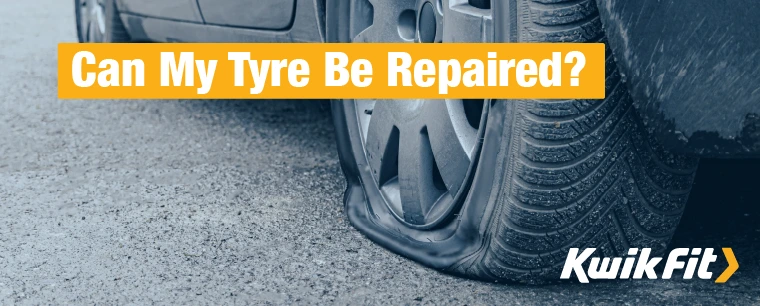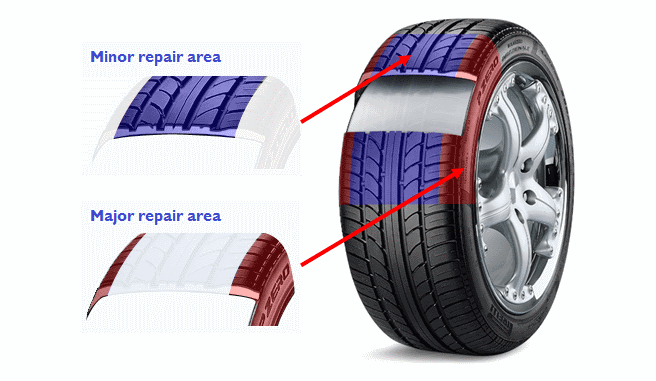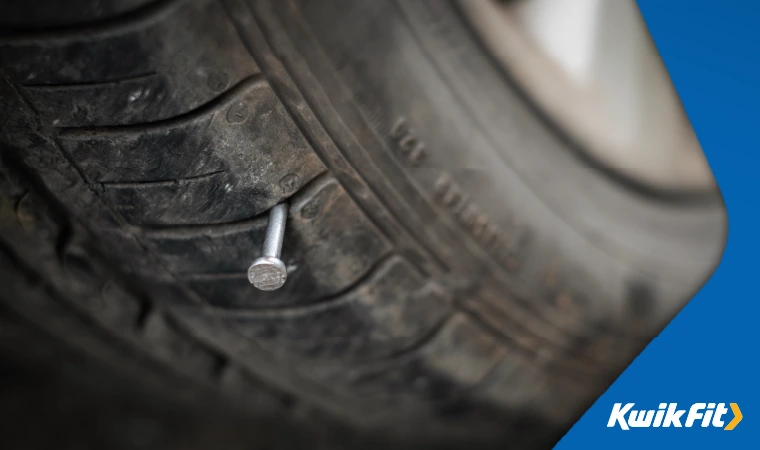Can My Tyre Be Repaired?
Jack Dreyer | Wednesday 22nd November 2023 11:00am

Nobody wants to pick up a puncture, especially when a flat tyre is almost guaranteed to happen at the most inconvenient time.
When a puncture occurs, itís understandable that youíd want to try and repair that tyre rather than replace it, even more so if youíve not long purchased the offending tyre. At Kwik Fit, we will always try to repair a punctured tyre but there are instances when this just isnít possibleÖ
Read on to discover the key factors that determine whether you can or canít repair your punctured tyre.
Understanding the location & severity of a puncture

Our car puncture repair policy reflects that of the British standard (BSAU159). This standard defines the requirements for safe minor tyre repair and its proximity to the sidewall. To remain compliant, we are only able to carry out tyre repairs to the central ĺ of the tyre (known as the minor repair area). If the puncture is situated outside of this area, even in the case of a slow puncture, it is deemed too close to the sidewall to guarantee a safe and lasting minor repair.
So why canít the sidewall of the tyre be repaired? The sidewall is the part of the tyre which sustains the most load when the tyre is in use. When a tyre undergoes a minor puncture repair, the damaged area is prepared using an air drill. While perfectly safe when used in the minor repair area of the tyre, the process could potentially weaken the structure of the sidewall. The sidewall also endures the most flex in the tyre which means a repair patch applied to this area is far more likely to detach as a result of this increased movement, leading to tyre failure.
Because the sidewall is not part of the minor repair area it is important that you do not drive on a flat tyre (unless it is a run flat tyre) in order to maximise the chances of being able to repair it. Without the air pressure to keep its shape, the tyre sidewall will be pinched between the wheel rim and the road when driving, severely damaging it. So, even if your puncture is located in the minor repair area, if you drive on the deflated tyre it may not be repairable due to additional damage sustained to the tyre sidewall.
What is the size of a puncture's area?

Just because the puncture has occurred in the minor repair area, doesnít necessarily mean it can be mended. British standard BSAU159 also defines the maximum size of the damaged area in order to carry out a safe repair.
If the diameter of the damaged area is larger than 6mm, a repair should not be attempted. This means it may be possible to repair a tyre that has been pierced by a nail or a screw, but if the damage is caused by a larger item such as a bolt or other metallic debris, the tyre may need to be replaced. This also means that tyre damage such as splits, cuts, and gouges cannot be repaired.
What is the condition of the tyre?
Every time we carry out a tyre change, we check the general condition of the tyre to make sure it is fit for repair. The legal limit for tyre tread in the UK is 1.6mm across the central ĺ of the breadth of the tyre tread.
If the remaining tread is less than 1.6mm anywhere around the entire circumference of the tyre or the sidewall exhibits bulging or exposed cords then a repair should not be attempted as the tyre is no longer fit for purpose. Not only is it against the law to drive a vehicle with tyres below the legal limit, itís also a major safety risk. Besides the increased risk of a blowout, the braking distance of your vehicle will increase as tyres become heavily worn, particularly in wet conditions where braking performance deteriorates still further.
Why canít run-flat tyres be repaired?
Run flat tyres have reinforced sidewalls which means they can be driven on for a short time after picking up a puncture, allowing you to make it to safety, be that your home or your nearest tyre fitter. Keep in mind that, should you get a puncture on a run flat tyre, you need to drive slowly and not any further than 50 miles and should seek assistance from a garage as soon as possible.
Unfortunately, when a run flat tyre picks up a puncture, it can be hard to tell if the structure of the tyre wall has been compromised. This is because the punctured tyre could have been driven on for an excessive amount of time or at unsuitable speeds (over 30mph) Ė but the added strength of the run flat tyre can mask this damage. For this reason, we cannot carry out minor repairs to run flat tyres as the tyre may no longer be safe to use.
Puncture repair made simple
If you are looking for a tyre puncture repair, or have concerns about your tyre tread or the general condition of your tyres, book a free tyre safety check at your local Kwik Fit centre. Alternatively, if you need a car tyre puncture repair and can't get to your nearest centre, why not try our mobile tyre-fitting service? Weíll come to you, whether youíre at home or at work.
Any facts, figures and prices shown in our blog articles are correct at time of publication.
Featured Articles
Is it Illegal to Drive With One Headlight?
Saturday 19th July 2025
Wondering if itís illegal to drive with one headlight? Learn about the safety risks and penalties of illegal blown bulbs and why you should fix them promptly.
Air Con in EVs & Hybrids: Experts Answer Your Questions
Monday 30th June 2025
Does air con drain EV batteries? Can you use the air con while charging an electric car? Find out the answers to these questions & more from Kwik Fitís experts.
Why Is Your Car Making a Noise? Fixes & Tips
Friday 13th June 2025
When your car starts making unexpected noises, it can certainly be quite disconcerting; it may be nothing to worry about, but hereís what you need to know.









